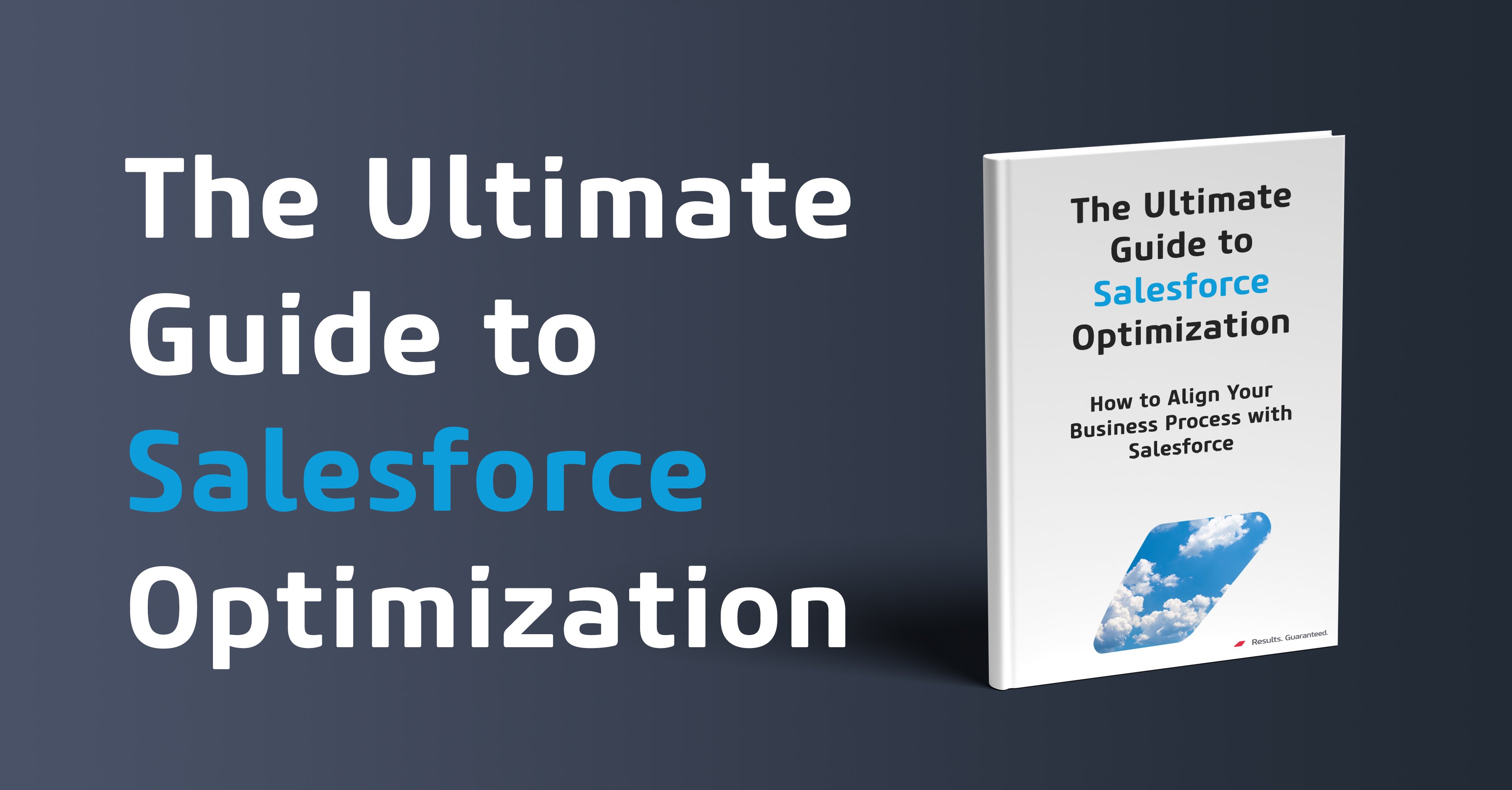Marshall Cram & Brock Newitt
Would it be correct to assume you aren’t using your Salesforce platform today to its full potential? Probably.
Salesforce is a powerhouse CRM, capable of catapulting businesses to new heights by streamlining customer relations and internal processes.
However, unlocking Salesforce's potential requires meticulous alignment with business processes and optimal utilization of its multiple functionalities.
Learn More About Our Salesforce Consulting Solutions
It might help to know you're not alone. We've put together this guide on Salesforce Optimization based on the countless conversations we have with clients across the country who are looking to get more out of their Salesforce investment. This guide is designed to help you get started by looking at how to practically align your business process with Salesforce and provide you with actionable strategies and insights.
How to Optimize Your Salesforce Platform?
You've invested considerable effort into setting up Salesforce the right way. You're satisfied with your decision, and it seems like you're reaping the benefits of the solution. However, as the annual costs of maintaining the platform increase, you may find yourself pondering a few crucial questions: What is the return on investment (ROI) of my Salesforce implementation? Are my business processes aligned with Salesforce, or is Salesforce aligned with my business processes? At Online, we understand the importance of answering these questions.
We’ll delve into seven strategies to help you unlock the full potential of Salesforce, ensuring optimal results and increased ROI for your business.
Table of Contents:
- Implement Customization and Personalization
- Take Informed Decisions: Advanced Analytics & Reporting
- Implement Efficient Automation
- Develop User Training & Adoption Programs in Salesforce
- Maintain Data Integrity as a Salesforce Success Pillar
- Synchronize Salesforce Configurations
- Audit Your Salesforce Capabilities Through AppExchange
1. Implement Customization and Personalization
Several organizations lack insight into how Salesforce can significantly enhance user satisfaction and drive operational efficiencies, often struggling to align the myriad functionalities of the CRM with their overarching business objectives and user needs.
This is where fine-tuning your experience with Salesforce becomes critical, ensuring it resonates with your unique business needs and preferences. This involves meticulous review and crafting in areas such as:
- Custom fields
- Custom objects
- User interface refinement
- Enhanced user interaction
- Data accuracy to streamline processes
Example: For instance, a retail company can customize Salesforce dashboards to display customer purchasing behaviours and preferences, enhancing their marketing strategies and customer interactions.
2. Take Informed Decisions: Advanced Analytics & Reporting
Organizations often overlook Salesforce's robust analytics and reporting tools, missing out on the opportunity to benefit from the advanced analytics capabilities it offers.
We have listed a few areas where advanced analytics and reporting can be used to optimize your platform:
Design Insightful Dashboards: Develop dashboards utilizing Salesforce Analytics for real-time data visualization and trend analysis. For example. a sales dashboards for your sales team, could include:
- Pipeline generation dashboard
- Sales lead dashboard
- Win/loss dashboard
- Sales leaderboard
- Sales rep performance dashboard
- Forecasting dashboard
- State of sales dashboard
What are Salesforce Sales Dashboards?
A Salesforce Sales Dashboard is a visual encapsulation, predominantly illustrated through graphs or charts, of pivotal sales metrics embedded within Salesforce’s CRM. It consolidates correlated metrics to present an intuitive, panoramic view of progress against sales benchmarks. Deploying dashboards strategically can highlight sales trends and areas for improvement.
Monitor Performance Continuously: Salesforce provides a comprehensive suite of tools and functionalities designed to enable businesses to keep a close eye on their performance metrics. By using the power of Salesforce's advanced reporting capabilities, organizations can maintain a proactive approach, making adjustments in real-time to maximize efficiencies and effectiveness. Here are a few points to look out for:
-
Dynamic Reporting: Salesforce offers dynamic reporting capabilities, allowing teams to generate real-time reports that capture live data. This means teams can view the latest metrics at any given moment, ensuring they are always working with the most up-to-date information.
-
Scheduled Reports: Automate your monitoring with daily, weekly, or monthly generated reports sent directly to your inbox.
-
Performance Alerts: Set key performance metrics and receive instant alerts when specific thresholds are crossed, enabling swift action.
-
Customizable Report Formats: Whether you prefer pie charts, bar graphs, or tabular data, Salesforce allows for customizable report formats to suit your preferences, making data interpretation easier and more intuitive.
-
Collaborative Sharing: Use Salesforce's collaborative features to share reports and dashboards with team members. This promotes transparent communication, ensuring everyone is on the same page and can act cohesively.
Example: A retail chain can utilize Salesforce reporting tools to monitor inventory levels across multiple locations in real-time. If a particular product's inventory drops below a set level, the procurement team can receive an immediate alert, ensuring timely restocking and preventing potential stock-outs.
3. Implement Efficient Automation
Salesforce's powerful automation engine can be used to streamline activity, reduce manual activities, enhance productivity and mitigate the risks of manual errors.
If there is a common pattern of behaviour or a predictable set of activities, Salesforce's automation tools can be leveraged.
But remember: effective automation isn’t about blindly replacing human effort with technology. It’s about ensuring that the technology serves as an enabler, complementing and streamlining your processes in alignment with your business's goals and structure. Here are three principal domains.
Identify Areas for Automation: Begin by taking a close look at your existing processes.
- Value Mapping: Create a map of activities that directly bring value to your business. If certain tasks are repetitive and don't necessarily require human judgment, they are prime candidates for automation.
- Pain Point Identification: Engage with your team and identify tasks they find time-consuming or error-prone. Automating such tasks can drastically improve team morale and efficiency.
- Data Flow Analysis: Track the flow of data across your processes. Automating data transfer and entry can not only save time but also ensure data consistency and accuracy.
Implement Workflow Rules: Salesforce offers several tools for setting up automation.
- Workflow Rules: These allow you to set up simple if/then statements. For instance, if a lead status changes to "Interested", then an email can be automatically sent to the sales representative.
- Process Builder: For more complex processes, the Process Builder allows you to create a visual representation of your process flow, incorporating multiple criteria and actions.
- Flow Builder: For advanced automations, Flow Builder can be used to create visual workflows, allowing for complex logic, loops, and even integrating with external systems.
Evaluate Automation Impact: Automation is a continual process. You should always be evaluating and refining.
- Feedback Mechanism: Engage with your team regularly to gather feedback on automated processes. They can provide valuable insights into what's working and what's not.
- Performance Metrics: Set up metrics to measure the effectiveness of your automation. For example, track the time saved, the accuracy of data, or the increase in lead conversions due to automated follow-ups.
- Iterate and Improve: Based on feedback and metrics, continually refine your automation rules and processes for optimum efficiency and effectiveness.
Example: An e-commerce company that uses Salesforce. Previously, every time a product went out of stock, a manual check was required before informing the procurement team. By automating this process, as soon as the inventory for a particular product falls below a certain threshold, an automated alert can be sent to the procurement team, ensuring timely restocking and potentially preventing loss of sales.
By following this structured approach, you can ensure that your organization is not just automating for the sake of it but is truly transforming its operations in a way that aligns with your business goals.
4. Develop User Training & Adoption Programs in Salesforce
Creating effective Salesforce training programs is crucial to ensure that your team can make the most out of the platform, boosting user proficiency and promoting the adoption of Salesforce’s extensive features.
Learn More About Our Salesforce Consulting Solutions
Create Targeted Training Programs: Develop user-focused training programs emphasizing Salesforce features and user needs.
Engage & Gather Feedback: Maintain continuous engagement with users and stakeholders and refine training programs based on their feedback.
Provide Ongoing Support: Offer continuous support and mentoring to address user challenges and foster a culture of continuous learning.
Example: A manufacturing firm might conduct Salesforce training sessions focusing on inventory management features, ensuring that the logistics team can accurately track and manage inventory levels.
5. Maintain Data Integrity as a Salesforce Success Pillar
Maintaining impeccable data integrity is foundational to leveraging Salesforce effectively, ensuring accuracy, reliability, and compliance which, in turn, builds trust and improves decision-making processes within your organization.
Implement Data Quality Management: Establish rigorous practices including deduplication and regular audits to ensure data accuracy and reliability.
Conduct Root Cause Analysis: Perform in-depth analyses to identify and resolve the root causes of data quality issues, aligning practices with business goals.
Establish Data Governance Policies: Develop robust data governance policies to maintain data quality, security, and compliance with industry standards.
Example: A healthcare provider may implement strict data governance policies in Salesforce to manage patient information securely, ensuring compliance with HIPAA regulations.
6. Synchronize Salesforce Configurations
Regularly refining Salesforce configurations is pivotal to keeping the platform aligned with the evolving business goals and user needs, ensuring a harmonious and enhanced user experience.
Review & Optimize Configurations: Regularly review and modify configurations, layouts, and fields to align with changing business goals.
Develop Strategic Implementation Plans: Create detailed implementation plans for each configuration change, ensuring smooth transitions and minimal disruptions.
Monitor & Optimize Continuously: Set up mechanisms for ongoing monitoring and optimization of configurations to ensure long-term alignment with business processes.
Example: An educational institution might refine Salesforce configurations periodically to align with academic cycles, optimizing user experience during admissions and enrollments.
7. Audit Your Salesforce Capabilities Through AppExchange
Salesforce's AppExchange is a treasure trove of applications designed to supercharge your Salesforce experience. It’s not just about adding new features; it's about finding the right tools that align with your business needs, enhancing the overall functionality of your Salesforce CRM, and ensuring seamless integrations for holistic operations.
Diving into AppExchange can seem overwhelming due to the abundance of available apps. Here's an approach to guide you in making the best out of AppExchange:
Select Apps Strategically:
- Needs Analysis: Before browsing AppExchange, list down the specific needs or challenges your organization faces which Salesforce's standard functionalities aren't addressing.
- Research and Reviews: Once you’ve identified potential apps, delve into the reviews. Other users' experiences can provide invaluable insights into the app's real-world performance.
- Compatibility Check: Ensure the app is compatible with your Salesforce edition and doesn't require additional systems or platforms that you might not possess.
- Trial Runs: Many apps offer trial periods. Make use of this to test the app in a sandbox environment to see if it truly aligns with your requirements.
Align Added Functionalities:
- Integration Testing: Before full deployment, test the app in a subset of your operations to ensure it integrates well with your existing processes.
- Training: Offer training sessions to your team focusing on the new functionalities. A tool is only as good as the user's ability to wield it.
- Document Changes: Maintain a record of all added functionalities and any changes to processes. This documentation can be invaluable for onboarding and troubleshooting.
Assess App Performance:
- Performance Metrics: Define clear metrics to evaluate the app's performance. This could be in terms of time saved, increase in data accuracy, user satisfaction, or any other relevant KPI.
- Regular Audits: Schedule periodic audits of the app's performance, ensuring it continues to meet your needs and doesn't become a redundant tool.
- Stay Updated: App developers frequently update their apps for better performance, added features, or to patch known issues. Ensure you are on top of these updates to get the best out of your chosen apps.
Example: One recommended tool on AppExchange is the Salesforce Optimizer App. Organizations that felt overwhelmed with their growing Salesforce configurations have turned to the Optimizer for guidance. After integrating the Salesforce Optimizer App from AppExchange, they received comprehensive reports highlighting areas of their Salesforce setup that were underutilized, configurations that might be redundant, or security measures they might have overlooked. This allowed them to streamline their processes, ensure best practices, and ultimately get more out of their Salesforce investment.
What is Salesforce Optimizer?
Salesforce Optimizer is an App that evaluates your Salesforce instance to determine how your company uses Salesforce features, then generates concrete recommendations for how you can optimize feature usage, including ways to simplify customizations and drive user adoption.
Final Thoughts:
Optimizing Salesforce and aligning it with business processes can significantly amplify operational efficiency and user experience. This provides an overview of how to get started and areas to consider for businesses seeking to maximize Salesforce's capabilities, driving growth and enhancing decision-making.
To truly use the power of Salesforce, understanding and aligning it with your unique business needs is key. By continuously optimizing and aligning Salesforce with your business processes, you not only unlock its full potential but also pave the way for business success.
Are you looking to optimize your Salesforce ecosystem and get the ROI out of the platform? Contact us today or check out our Salesforce Consulting Solutions.




Submit a Comment